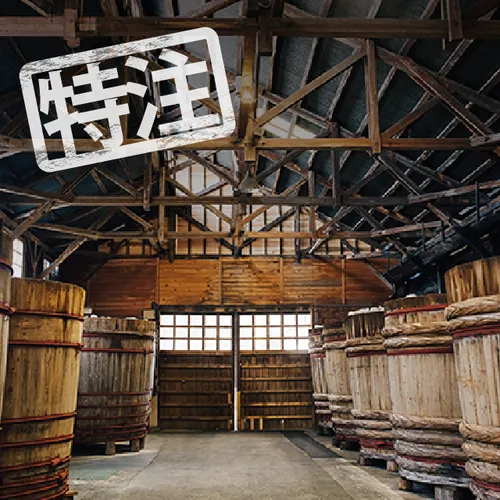to modern time.


 ──About how many miso companies currently exist nationally?
──About how many miso companies currently exist nationally?
Noda : It should be around 1000. More than half of them is a family-owned business with only a few employees that do business locally.
Although, smaller businesses are on the decline. For example, my hometown Aichi ranks 2nd in the volume of miso produced nationwide, yet the 200 miso warehouses that were around during my grandfather’s time has now decreased to about 30 to 40 warehouses.
The custom of Japanese to eat miso has also dwindled and become challenging to only do business locally. Yet, when it is a family-owned business, it is not realistic to prepare facilities big enough to distribute products nationwide.
Noda : Actually not. Only a few products from big manufacturers can be found in supermarkets nationwide, and the popular miso nowadays does not require long fermenting and maturing time.
However, miso made traditionally takes 6 months to a year, sometimes more than that to carefully ferment and mature to create miso that is deep in flavor. I’m not saying which is better, the difference actually works well to differentiate each other.
Noda : Yes, that is true. Miso used in restaurants are the same way also, so I’ve always felt a little sad in how people base their norm to that.
 ──Please tell me about Noda miso -the company that you have inherited.
──Please tell me about Noda miso -the company that you have inherited.
Noda : Noda Miso is a miso warehouse in Toyota city, Aichi that has been around for 90 years. Its history and business size lie in the middle of the industry.
We practice ‘natural fermentation’, which is to slowly mature the miso according to Japan’s seasonal temperature difference without manually controlling the temperature. Another big trait is only wooden barrels used for the aging process, and the number of those barrels is one of the highest in Japan. By the way, miso aged in wooden barrels only accounts for less than 5% nationally.
Noda : We believe microorganisms reside in wooden barrels and we call it ‘Oke tsuki kin(microbes living in barrel). Multiple microbes such as koji mold, yeast, and lactic acid bacteria and others play a role in the fermentation as well as the maturing process that brings out the intricate yet deep flavor of the miso.
──Just like the traditional secret sauce made by adding to the existing sauce, does it mean the wooden barrels creates a distinct flavor that can only be created by using it over time?Noda : Exactly. The flavor depends greatly on the balance of the microorganisms. We call it the trait of the barrel or the trait of the warehouse as each warehouse as well as each barrel has its own characteristic.
To understand the fundamental purpose of wooden barrels, I’ve tried taking it to a specialized organization to examine the scientific aspect but was turned down since the number of the microorganisms was too much.
 ──You are involved in promoting activities such as ‘Recommending Homemade Miso’, but what have motivated you to start this?
──You are involved in promoting activities such as ‘Recommending Homemade Miso’, but what have motivated you to start this?
Noda : When I was running a restaurant specializing in miso cuisine with a friend, I noticed how miso was not properly understood to the public. For example, it seemed as there were a lot more people that knew a lot more about wine, so in order to promote the right understanding about miso, I started activities such as offering miso preparing classes 4 years ago.
We say ‘We don’t make miso, but raise it’. It is very exciting to watch how the color, flavor, and aroma all change in the process of fermenting and maturing. Since there is a rise in interest to handmade nowadays, it made me think it may spark interest in the public.
Noda : According to the survey conducted to the participants, most of the reasons for participation were to simply enjoy the making process and interests in fermented food.
The next reason is their wish for safe and secure food. Miso made by your own hands only uses simple ingredients such as soybeans, salt, water, and rice koji, so there a lot of parents who want to feed it to their children.
Another reason is that because I am a professional miso maker. There are other miso classes offered yet it’s rare an actual miso maker teaches you directly.
 ──That’s true! It’s very fortunate that an expert in miso will teach you directly how to make miso!
──That’s true! It’s very fortunate that an expert in miso will teach you directly how to make miso!
Noda : Yes, well making miso is my actual job. lol. As a miso maker, we take pride in follow-up services. Miso is not completed at the end of the class so, to safely enjoy the process of fermenting and maturing at home, we offer online support until it’s completed.
 ──Due to such background, otemae’s ‘homemade-miso kit’ was introduced to enjoy at home, but what triggered you to start the business?
──Due to such background, otemae’s ‘homemade-miso kit’ was introduced to enjoy at home, but what triggered you to start the business?
Noda : Preparing homemade-miso has been done at each household back in the days, so it made me think whether if a lot of people could have a chance to experience this once again.
A lot of people wonder if it requires a certain level of knowledge, and the answer is no. Including small children, it is made very simple for anyone to enjoy that wants to try.
Noda : Otemae’s Beginner course is very simple as to just ‘prepare in a container’. When you divide the process of preparing homemade-miso into steps, as long as the process of mixing the ingredients has gone well, there is no way to fail afterward. Therefore, it’s as to receive what the professional has prepared halfway and only take it to the goal.
──That seems simple enough for anyone to enjoy. How about the intermediate course?Noda : The intermediate course includes actual miso making steps such as mashing the soybeans and mixing rice koji and salt with your hands. There are a lot of steps to actually do with your own hands and you can specifically see the ingredients as well so if you want to pursue more hands-on, I recommend this course.
 ──How much do the flavor and the condition change depending on who makes it?
──How much do the flavor and the condition change depending on who makes it?
Noda : It changes drastically! Depending on the person as well as the location where it has been stored. Even if in the same city such as Tokyo, it differs greatly if it is an apartment or a Japanese-style house, or depending on which room it’s stored as the atmosphere changes.
Repeating participants of the miso class bring me the final product they have made, and when you compare it with participants from the same group, the color, flavor and the final condition all differ greatly.

Homemade-miso kit Beginner
Kome Miso 2kg
Buy from Here

Homemade-miso kit Beginner
Mame Miso 2kg
Buy from Here

Homemade-miso kit Beginner
Kome Miso 4kg
Buy from Here

Homemade-miso kit Beginner
Mame Miso 4kg
Buy from Here

Homemade-miso kit Intermediate
Kome Miso 2kg
Buy from Here

Homemade-miso kit Intermediate
Mame Miso 2kg
Buy from Here

Homemade-miso kit Intermediate
Kome Miso 4kg
Buy from Here

Homemade-miso kit Intermediate
Mame Miso 4kg
Buy from Here

Made to order
Buy from Here
 ──The craftsmen that collaborated with the creation of ‘Tools of Craftsmen’ were appointed by Mr. Noda. How did you choose them?
──The craftsmen that collaborated with the creation of ‘Tools of Craftsmen’ were appointed by Mr. Noda. How did you choose them?
Noda : The collaborator of the ‘Craftsmen’s craft wooden bucket’ has been barrel craftsmen Mr. Hisada (from Tarutou Youki Kougyousyo). I have done business with him before through Noda Miso and he is someone who will listen to my sometimes extreme requests.
The idea to invent new tools is sometimes hesitated by craftsmen but Mr. Hisada is someone that when I convey my thoughts and ideas, he will take an interest and tries to respond with all the skill he has.
Noda : Yes indeed. And it’s satisfying to know that it comes from someone that knows the background of the traditional process.
I have mentioned earlier but wooden barrels that become the house of the microorganisms are very important based on how we think miso is made. There are new and handy items such as plastic containers, but it should be a great joy to enjoy the making process in conjunction with enjoying the traits of Japan’s traditional wooden container as well.
Noda : ‘Craftsmen’s craft stone weight’ was created with the help of stonemason Mr. Chiba (from Inuzuka Sekizai Honten). When I first brought this idea to him, he was like “Huh?” with his strong face, and I was a little frightened by him. lol.
But after exchanging some communications, he would start sharing with me some ideas on how to make it more interesting. The stone weight looks simple but contains a very important request.
Noda : Before reaching Mr. Chiba, I was actually turned down from other places numerous times so I only have respect for him. His pride in his work and his knowledge and skills are brilliant so I’m very proud of how it turned out. It was a great pleasure working with him.
 ──With the ‘homemade-miso kit’ becoming one product, it seems as there would be a new expansion from here.
──With the ‘homemade-miso kit’ becoming one product, it seems as there would be a new expansion from here.
Noda : Yes, I hope so. I feel a lot of people nowadays looking for something that has actually already been there. So if you change it up to date and propose, there could be something happening from it.
Especially I hope it reaches out to the younger generation. When living an ordinary life, making miso properly is something uncommon and I understand that there is a large wall to step into that region since I was once that age, but because so, I would like to continue conveying the importance of experiencing a rich food experience from early on.











